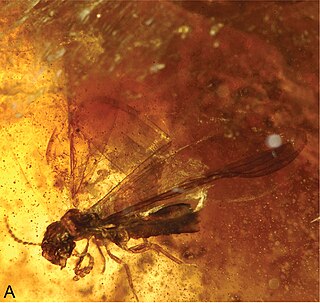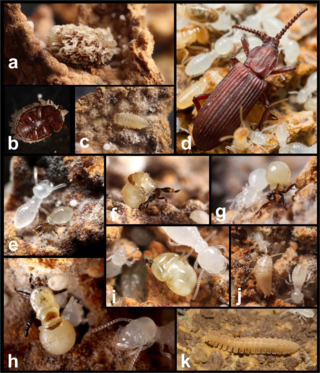
Termites are a group of detritophagous eusocial insects which consume a wide variety of decaying plant material, generally in the form of wood, leaf litter, and soil humus. They are distinguished by their moniliform antennae and the soft-bodied and often unpigmented worker caste for which they have been commonly termed "white ants"; however, they are not ants, to which they are only distantly related. About 2,972 extant species are currently described, 2,105 of which are members of the family Termitidae.
Leaf mold is the compost produced by decomposition of shaded deciduous shrub and tree leaves, primarily by fungal breakdown in a slower, cooler manner as opposed to the bacterial degradation of leaves.

Trichonympha is a genus of single-celled, anaerobic parabasalids of the order Hypermastigia that is found exclusively in the hindgut of lower termites and wood roaches. Trichonympha’s bell shape and thousands of flagella make it an easily recognizable cell. The symbiosis between lower termites/wood roaches and Trichonympha is highly beneficial to both parties: Trichonympha helps its host digest cellulose and in return receives a constant supply of food and shelter. Trichonympha also has a variety of bacterial symbionts that are involved in sugar metabolism and nitrogen fixation.

A wood-decay or xylophagous fungus is any species of fungus that digests moist wood, causing it to rot. Some species of wood-decay fungi attack dead wood, such as brown rot, and some, such as Armillaria, are parasitic and colonize living trees. Excessive moisture above the fibre saturation point in wood is required for fungal colonization and proliferation. In nature, this process causes the breakdown of complex molecules and leads to the return of nutrients to the soil. Wood-decay fungi consume wood in various ways; for example, some attack the carbohydrates in wood, and some others decay lignin. The rate of decay of wooden materials in various climates can be estimated by empirical models.

Termitomyces, the termite mushrooms, is a genus of basidiomycete fungi belonging to the family Lyophyllaceae. All of which are completely dependent on fungus-growing termites, the Macrotermitinae, to survive, and vice versa. They are the food source for these termites, who enjoy an obligate symbiosis with the genus similar to that between Atta ants and Attamyces mushrooms. Termitomyces mushrooms are edible, and are highly regarded for their flavor.

The Macrotermitinae, the fungus-growing termites, constitute a subfamily of the family Termitidae that is only found within the Old World tropics.

Termitidae is the largest family of termites consisting of 2,105 described species of which are commonly known as the higher termites. They are evolutionarily the most specialised termite group, with their highly compartmentalized hindgut lacking the flagellated protozoans common to "lower termites", which are instead replaced by bacteria and archaea. Whereas lower termites are restricted mostly to woody tissue, higher termites have diverse diets consisting of wood, grass, leaf litter, fungi, lichen, faeces, humus and soil. Around 60% of species rely on soil-feeding alone.

Globitermes sulphureus is a species of termite that is very common in central and southern Vietnam and also present in other areas of South East Asia, including Cambodia, Thailand, and Peninsular Malaysia. They live in nests made of earth that can be up to 1.5 m tall and can contain tens of thousands of individuals. Between five and 10 per cent of the population are soldier termites which can be recognised by their yellow abdomen and two large, curved mandibles. The termites use autothysis as a defense mechanism.

Macrotermes bellicosus is a species of Macrotermes. The queens are the largest amongst known termites, measuring about 4.2 inches (110 mm) long when physogastric. The workers average 0.14 in (3.6 mm) in length and soldiers are slightly larger. Bellicosus means "combative" in Latin. The species is a member of a genus indigenous to Africa and South-East Asia.

Termitotroginae is a monotypic subfamily of the family Scarabaeidae, the scarab beetles. The only genus in the subfamily is Termititrox. A second genus, Aphodiocopris, Arrow, 1920, has been synonymised with Termitotrox. All known members of this subfamily are tiny, blind and flightless, and are termitophiles, dwelling within the fungal gardens of colonies of species of termite in Africa or tropical Asia.

Termitotrox cupido is a species of scarab beetle in the subfamily Termitotroginae. It was first described by Munetoshi Maruyama in 2012, having been discovered living inside a nest of the termite Hypotermes makhamensis in Cambodia. It is a tiny, blind and flightless insect.

Macrotermes michaelseni is a species of termite in the family Termitidae, found in sub-Saharan Africa. It is associated with the fungus Termitomyces schimperi.

Macrotermes is a genus of termites belonging to the subfamily Macrotermitinae and widely distributed throughout Africa and South-East Asia. Well-studied species include Macrotermes natalensis and M. bellicosus.
Odontotermes redemanni, is a species of termite of the genus Odontotermes. It is native to India and Sri Lanka. It damages wooden constructions. It is a pest of sugarcane, tea and coconut. They construct termitaria during November to March when rainfall and ambient temperature become low. Underground termite nests of this species are a natural host for the important Traditional Chinese Medicine fungus Xylaria nigripes, also known as Wu Ling Shen.

Macrotermes carbonarius, also known as Kongkiak in Malay, is a large black species of fungus-growing termite in the genus Macrotermes. It is one of the most conspicuous species of Macrotermes found in the Indomalayan tropics, forming large foraging trails in the open that can extend several metres in distance. M. carbonarius is a highly aggressive species with the soldiers possessing large curving mandibles that easily break skin. It is found in Cambodia, Malaysia, Myanmar, Singapore, Thailand and Vietnam.
Marginitermes hubbardi, commonly known as the light western drywood termite, is a species of termite in the family Kalotermitidae. It is found in Central America and desert regions of southwestern North America.

Odontotermes is a termite genus belonging to subfamily Macrotermitinae, which is native to the Old World. They are most destructive in wooden homes, and are agricultural pests in the tropics and subtropics of Africa and Asia. It is the most diverse termite genus in Africa, with 78 species recorded.

Odontotermes obesus is a species of termite in the family Termitidae. It is native to tropical southwestern Asia. This termite cultivates a symbiotic fungus in a special chamber in the nest. Workers gather vegetable detritus which they bring back to the colony, chewing up the material to make a suitable substrate on which the fungus will grow.

Odontotermes formosanus is a species of fungus-growing termite in the family Termitidae. It is native to southeastern Asia and was first described from Taiwan. This termite cultivates a symbiotic fungus in a special chamber in the nest. Workers and soldiers gather vegetable detritus which they bring back to the colony, chewing the material to a pulp to make a suitable substrate on which to grow the fungus.

Microhodotermes viator, commonly called the southern harvester termite, the Karoo harvesting termite, the wood-eating harvester termite, houtkapper, and stokkiesdraer, is a species of harvester termite native to the desert shrubland of Namibia and South Africa. The eusocial insects inhabit soil mounds called heuweltjies. In 2024, researchers found inhabited Microhodotermes viator mounds up to 34,000 years old—by far the oldest active termite structures ever dated.















